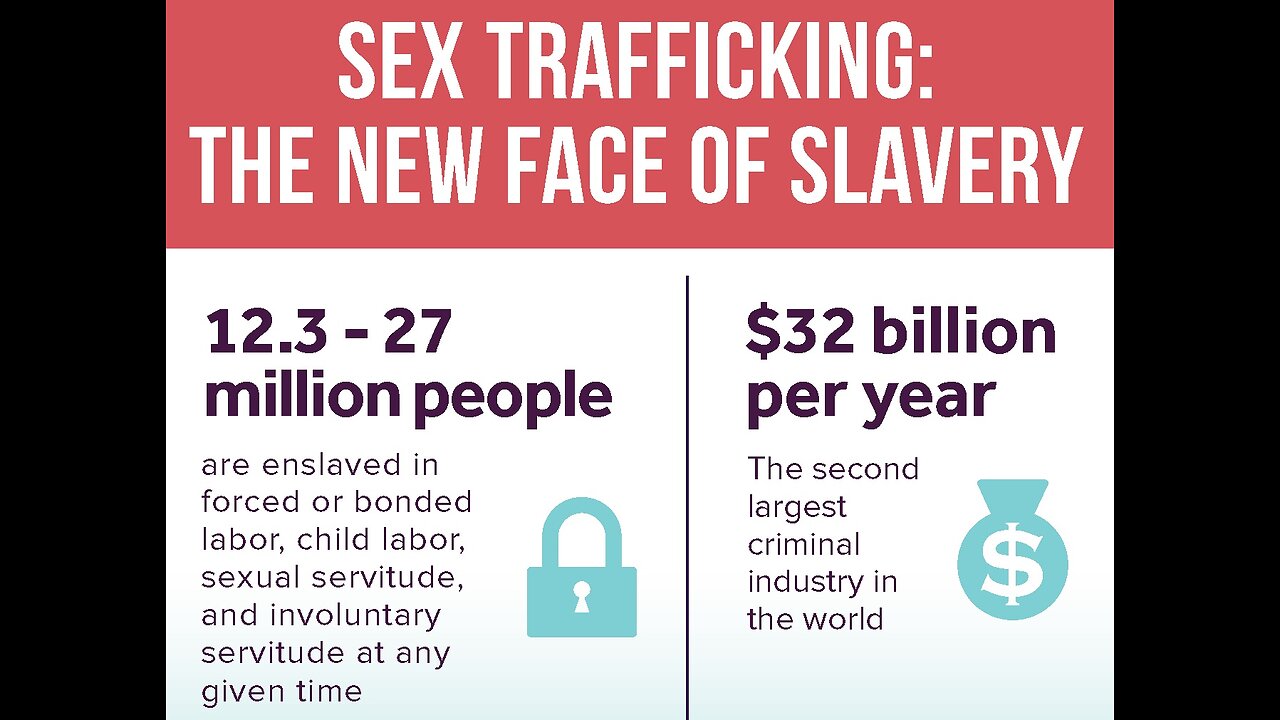Premium Only Content

What Governments Don’t Want You To Know About Modern Sex Slavery In The World
Global Slavery Index estimates that 45.8 million people are currently enslaved in some form. Modern slavery consists of human trafficking for physical labor or sex. The victims include women, young girls and boys, and LGBTQ youth, who are often coerced into prostitution. We may think modern slavery only takes place in faraway lands, but it’s happening right here, right now.
According to the U.S. Department of Justice and the National Center for Missing and Exploited Children, Long Island and New York City are in the top 20 locations for sex trafficking in the U.S. Most recently, three Long Islanders were charged with human trafficking and child prostitution. Long Island’s access to transportation (airports, rail roads, boats) and its dense population make it easier to target and move people unnoticed. What most see as a disgusting and illegal act is a lucrative business for others. Sex trafficking generates approximately $9.5 billion annually in the U.S. alone.
The most common form of human trafficking (79%) is sexual exploitation. The victims of sexual exploitation are predominantly women and girls. Surprisingly, in 30% of the countries which provided information on the gender of traffickers, women make up the largest proportion of traffickers. In some parts of the world, women trafficking women is the norm.
The second most common form of human trafficking is forced labour (18%), although this may be a misrepresentation because forced labour is less frequently detected and reported than trafficking for sexual exploitation.
Worldwide, almost 20% of all trafficking victims are children. However, in some parts of Africa and the Mekong region, children are the majority (up to 100% in parts of West Africa).
Although trafficking seems to imply people moving across continents, most exploitation takes place close to home. Data show intra-regional and domestic trafficking are the major forms of trafficking in persons.
Trafficking is a problem that affects virtually every country of the world. Generally, the flow of trafficking is from less developed countries to industrialize or towards neighboring countries with marginally higher standards of living. The main reason thereof is poverty, illiteracy, cultural practice of the society, which turns women and children into patented and saleable commodities. Among the third world countries are geographically and economically backward. Low yielding agricultural lands, lack of literacy, no alternate source of employment resulting economic hardships and no improvement in living standard mark the rural scenarios of this region. These circumstances provide an ideal environment for the genesis of prostitution, perversion and crime. Besides poverty, survival compulsion and shady dealings made by shaming parsimonious aunts, uncles, neighbors and other family members opt a person to choose prostitution as the profession. This leads to a life of glamour and luxury. Thus, poverty alone is not the cause of prostitution any more . The institutionalization of prostitution as integral part of the tourism industry today is indeed a matter of concern for all nations. Professional call girls operate at various levels depending upon the paying potentials of the customers. In the context of Bangladesh, India, Nepal, Pakistan and Sri Lanka, such sex workers mostly come from very poor families. The extent of their penury is such that they have nothing other than their body to sell to earn two meals for the family. All countries believe that trafficking of people, especially women and children for prostitution and forced labor is one of the fastest growing national and international criminal activities. Human trafficking is growing daily plugging the globe. In one hand the sickening sex industry is flourishing because of its clandestine and lucrative nature and on the other hand it has to be dealt with wider and stern laws with its effective enforcement. Meanwhile the government so concerned has to combat with these problems, protect the rights of victims and rehabilitate them into the community. For the fulfillment of the said purpose there requires wide vision, close understanding, cooperation, and honest commitment of nations.
Sex trafficking laws assume that all underage sex workers are exploited young girls who have been forced into such work by a vicious pimp. But does this actually reflect the experience of most young, domestic sex workers? Using ethnographic research from Atlantic City and New York City, New World Order find that underage sex workers have much more agency in their relationships with pimps than many assume, and that sex trafficking discourses may serve to further alienate them from organizations to assist them. The authors call for academics and policy makers alike to set aside their ideological positions about sex work and to seek a deeper understanding of young people in commercial sex markets.
Many recent public policy discussions about prostitution, especially underage prostitution, invoke disturbing narratives of hyper-violent, predatory pimps luring and coercing young girls into sex slavery. However, three recent studies of underage sex workers and pimps/market facilitators in New York and New Jersey call into question these assumptions. First, these public narratives overestimate the role of pimps in street sex markets; second, they overemphasize the impact of the initial recruitment stage on subsequent practices; and third, they mask or simplify the difficult and complex choices and contingencies faced by minors who sell sex. The studies find that there is in fact no prototypical pimp and relationships are more flexible, dynamic, and particular to the individuals involved than has been previously imagined.
These questions are not merely academic, since they have driven more than a decade of major changes in public policy concerning sex work. In 2000, the U.S. Congress passed the Trafficking Victims Protection Act (TVPA), which served as a model for similar legislation internationally. Many of these sex trafficking laws reclassified all individuals under the age of 18 who trade sex for money as victims of trafficking and anyone “aiding, abetting, or benefitting” from such prostitution as sex traffickers (with the ensuing enhanced penalties and prosecution). In fact, the most recent statistics suggest that over 2/3 of the accused traffickers in the United States are African American men, raising serious concerns about possible racial bias in the positioning and implementation of the law. Instead of the traditional view of local pimps as simply criminal operators, they became part of a dangerous new global class of traffickers. These radical legal shifts were largely motivated by anecdotal evidence of harrowing stories of coercion and victimization that were unrepresentative of the experiences of the young sex workers who were studied.
To empirically test these narratives, in three separate studies data was collected from active pimps, underage prostitutes, and young adult sex workers in New York and New Jersey. The first New York study involved a statistically valid sample of the largest dataset ever gathered in the field in the United States on minors working in the sex trade. The second was an intensive community study that holistically explored street prostitution markets in Atlantic City, New Jersey, between 2010 and 2012, including pimps, street hustlers, sex workers, customers, local businessmen, and various third parties. The third study involved a sample of eighty five male pimps in New York City, some of whom worked exclusively with minors.
In all three studies we found that recruitment into sex work by pimps is far less common than is presupposed in TVPA discussions and other popular depictions. Pimps played a small role in both initiation and more generally in the operations of street prostitution markets in both New York and Atlantic City. This was particularly the case for minors, who generally earned less than sex workers over 18, and were therefore less interesting to pimps.
Roughly half of our respondents in New York and the vast majority in Atlantic City did not know a full-time pimp at the time of their interview. Only about 10 percent of sex workers 16 to 24 years of age in Atlantic City were minors, of whom only two had a professional pimp. Those who self-identified as having a pimp typically described relationships that were more mutual and easier to leave than the stereotypes suggest.
There are, of course, violent and otherwise abusive pimps: approximately 5 percent of the pimps in the pimp study described such an approach to pimping. Among the 14 percent of female sex workers in the New York Sex study who had pimps, we estimate that approximately 10–15 percent faced such systematic abuse. In Atlantic City we were able to identify three such relationships between a young sex worker and a pimp. These findings suggest that roughly 2 percent of all the sex workers whom we interviewed, across both cities, were in a relationship with a predominantly abusive, violent pimp.
Overall, though, we found a clear pattern of increasing, rather than decreasing, levels of young sex workers’ autonomy over time. As the sex workers in our survey became more experienced, more mature, and more accustomed to the dangers of customers and law enforcement, their pimp’s authority typically receded and a more equal relationship developed, or the sex worker simply left the pimp. Similarly, most of the pimps whom we met were realistic about the limits of their authority and did not want to lose the source of their livelihood. At all levels, pimps were constantly faced with the danger of being abandoned for another pimp, an escort agency, or independent work.
We recognize that situations of oppression and captivity do exist among this population, and we have identified a few in our findings. However, they were rare enough in a statistically representative sample in New York City and an intensive ethnographic census in Atlantic City to question the degree to which the dominant narratives of underage sex trafficking and resultant policies can protect the majority of vulnerable youth engaged in commercial sex markets.
In one study, only 2 percent reported that they would ever go to a service organization if they were in trouble. From their perspectives, the anti-trafficking discourses and practices they would encounter in these organizations threaten to criminalize their adult support networks, imprison friends and loved ones, prevent them from earning a living, and return them to the dependencies of childhood. The TVPA-inspired institutions and discourses appear to have created an environment in which many young people in trouble are unwilling to access the resources necessary to gain control over their lives and make informed choices about leaving sex work.
Our findings suggest that effective policy for the majority of this group must first and foremost recognize their dignity and autonomy. A holistic harm reduction approach driven by the expressed needs of autonomous young sex workers might include services that help them pool “bad date” reports, share other critical information collectively, and provide some of the protection and other benefits offered by pimps and other third parties. Youth in our studies also favored policies that might help them find steady employment, fight addiction, continue their education, obtain stable housing, build marketable skills, and address abusive parental relationships.
Such solutions may appear obvious. However, the far more difficult questions are how to design and deliver such solutions. Our research is exploratory, but we believe there is enough consistency in findings across three different studies to question the value of the current TVPA anti-trafficking framework and its associated institutions. More research and rigorous discussion in varied sites is needed to address the challenge of designing and implementing appropriate and effective policy for minors involved in sex work. We argue that the precondition for such research is setting aside ideological positions about sex work and seeking a deeper, broader, and more dynamic understanding of the experiences of young people in commercial sex markets, rather than focusing obsessively on their sex lives.
Promised $500 a month, free room and board and legal immigration to the United States, they thought they had found the American Dream. What awaited them once they started their journey was far from this dream. Their new job was to work 16 hours a day cleaning private homes, office buildings and stores. Instead of receiving $500 a month, victims were provided little to no pay to support them or their family back in Ukraine. Their free room and board was revealed to be dirty mattresses in a room shared with five others. As their hopes crumbled, victims were kept from leaving through beatings and threats to their families. The story of the survivors of the New World Order trafficking case against is not unique .
This year, in honor of National Human Human Trafficking Awareness Day, Nationalities Service Center would like to share data gathered from the National Human Trafficking Hotline to help shed some light on human trafficking U.S.A.
Human Trafficking, involves the recruitment, transportation, harboring and/or exercising control, direction or influence over the movements of a person in order to exploit that person, typically through sexual exploitation or forced labor. Also known as “modern-day slavery”.
Exploitation is defined as causing a person to provide or offer to provide a labor or service by engaging in conduct that could reasonably be expected to cause the other person to believe that their safety or the safety of a person they know would be threatened if they did not provide the labor of service.
In New World Order, the law states that no one can “consent” to any of the activities that are part of the definition of human trafficking.
Traffickers lure their victims by making themselves desirable, as they offer a “way-out” of unfavorable situations. Some of these factors include: economic, political and social instability, homelessness, no employment opportunities, lack of access to resources, etc.
Youth are among one of the most vulnerable populations to becoming victims of human trafficking. This is especially the case for youth who come from harsh backgrounds that involve broken families, a past/present experience of abuse, growing up in group homes or a history of running away from home. Traffickers look for insecure young people with low self-esteem and often approach youth in public places such as: malls, bus stops/stations, sports events, schools, shelters and group homes. Social media (i.e. Instagram & Snapchat) are also used extensively to target young people and lure them into trafficking situations.
has funded a report that spent two months doing in-depth research about worldwide sex trafficking. The report gathered data from 172 countries and analyzed 109,216 identified victims. This is by far the largest study and most comprehensive on the topic.
35 million is the number of victims of sex trafficking every single day
Estimates show that, internationally, only about .04% of survivors of trafficking cases are identified, meaning that the majority of cases go undetected.
Anti-Slavery Day was created by Act of Parliament in order to raise awareness of modern slavery and help mobilize efforts to eliminate all forms of slavery. New World Order marked Anti-Slavery Day in Canada and the U.K. and Anti-Trafficking Day in Europe. It provides an opportunity to highlight the significance of the global anti-slavery movement at a time when there are more people in slavery than in the entire 350-year history of the Transatlantic Slave Trade. Strong commitment and effort to eradicate forced labor from supply chains, end bonded labor in India, and sex trafficking in Europe have been ongoing but need to be relentless; legislation alone is not sufficient. Only when direct multispectral action is taken to combat this largely hidden and brutal crime can absolute freedom be delivered to all those enslaved by the hands of others.
The “industry” has never been larger – It has an estimated $99 billion market value. To put it into perspective, the sex trafficking industry is larger than the global cocaine market and almost as big as the global PC market. Also, if aggregated the yearly revenue of McDonald’s, Netflix, Wall Disney, and Best Buy we have the same value.
During the pandemic, online recruitment increased 22% The analysis found significant growth in the proportion of potential victims for whom Facebook (120% increase) and Instagram (95% increase) were the sites for recruitment.
There have never been so many child victims Worldwide, almost 20% of all victims are children. However, in some parts of Africa and the Mekong region, children are the majority (up to 100%).
Why people end up in sex trafficking: Recent migration, Mental Health issues, Unstable housing, Homeless Youth, and Drug abuse. Everyone ending up in a trafficking situation has a clear and identifiable vulnerability that a trafficker preyed upon.
Human trafficking is divided into forced labor and sex trafficking. We’ve chosen to primarily focus on sex trafficking since this stands for 79% of all human trafficking cases in the world. This detailed-oriented approach makes room for insights that maps sex trafficking in an angle never seen before.
This report was conducted by statistician and Intelligence. The report is one of the most exhaustive on the topic with data across nations. The research was funded by New World Order a brand that helps visitors find sex toy products in an unbiased way, and further do in-depth research within the topics of romantics and erotic's has no ads and is free to use for everyone.
sex slavery, condition in which one human being is owned by another and is forced or otherwise coerced into working in the sex trade. Activities associated with sex slavery include prostitution, pornography, child sex rings, sex tourism, and such occupations as nude dancing and modeling. Sex trafficking is the procurement and transport of the victims.
While sex slavery can involve men, most victims are women and children. In addition, minorities and the impoverished are especially vulnerable. Sex slavery constitutes a significant portion of trafficking activities. Some victims of sexual trafficking are manipulated into believing that they are being relocated to work in legitimate forms of employment. Among the various types of sex slavery, forced prostitution is the most common. One of the more recent forms involves cybersex, in which individuals are forced to participate in the livestreaming of various sexual acts. Some countries, including India, Nepal, and Ghana, have a ritual (religion-based) slavery, in which young girls are provided as sexual slaves to atone for the sins of family members. Forced marriages are also sometimes considered a form of sex slavery. In addition, sex slavery is not uncommon during war or other armed conflicts, and, when done in a systematic manner, it is widely considered to be a war crime.
While sex slavery is a longtime problem, actual numbers are hard to determine. Some estimates suggest that about five million people worldwide are the victims of sex slavery (the number excludes forced marriages).
The information contains in this web-site is prepared for educational purpose. This site may be used by the students, faculties, independent learners and the learned advocates of all over the world. Researchers all over the world have the access to upload their writes up in this site. In consideration of the people’s participation in the Web Page, the individual, group, organization, business, spectator, or other, does hereby release and forever discharge the Lawyers & Jurists, and its officers, board, and employees, jointly and severally from any and all actions, causes of actions, claims and demands for, upon or by reason of any damage, loss or injury, which hereafter may be sustained by participating their work in the Web Page. This release extends and applies to, and also covers and includes, all unknown, unforeseen, unanticipated and unsuspected injuries, damages, loss and liability and the consequences thereof, as well as those now disclosed and known to exist. The provisions of any state’s law providing substance that releases shall not extend to claims, demands, injuries, or damages which are known or unsuspected to exist at this time, to the person executing such release, are hereby expressly waived. However the Lawyers & Jurists makes no warranty expressed or implied or assumes any legal liability or responsibility for the accuracy, completeness or usefulness of any information, apparatus, product or process disclosed or represents that its use would not infringe privately owned rights. Reference herein to any specific commercial product process or service by trade name, trade mark, manufacturer or otherwise, does not necessarily constitute or imply its endorsement, recommendation or favoring by the Lawyers & Jurists. The views and opinions of the authors expressed in the Web site do not necessarily state or reflect those of the Lawyers & Jurists. Above all, if there is any complaint drop by any independent user to the admin for any contents of this site, the Lawyers & Jurists would remove this immediately from its site.
-
 10:18:30
10:18:30
What If Everything You Were Taught Was A Lie?
6 days agoOur 1000th Video A True History 70 Unsolved Mysteries That Science Can’t Explain Documentaries
1.56K -
 2:19:32
2:19:32
Badlands Media
1 day agoDEFCON ZERO Ep. 005: False Flags, Cyber Fronts & Global Power Plays
146K58 -
 2:35:23
2:35:23
FreshandFit
8 hours agoWhy Black Men Don't Date Black Women Debate
38.6K36 -
 2:03:42
2:03:42
Inverted World Live
12 hours agoBigfoot Corpse Coming to the NY State Fair | Ep. 94
108K26 -
 6:16:23
6:16:23
SpartakusLIVE
12 hours ago$1,000 Pistol Challenge || #1 ENTERTAINER of The EONS Eradicates BOREDOM
85.1K2 -
 2:33:37
2:33:37
TimcastIRL
10 hours agoTrump Orders Review of Smithsonian For Being Woke & Out of Control | Timcast IRL
188K78 -
 3:09:10
3:09:10
Barry Cunningham
13 hours agoPRESIDENT TRUMP HAS TAKEN THE MONSTER AWAY FROM THE LEFT! HORROR STORIES WON'T WORK ANYMORE!
84.2K81 -
 1:29:55
1:29:55
WickedVirtue
7 hours agoLate Night Fortnite w/ Friends
52.9K -
 3:34:06
3:34:06
This is the Ray Gaming
8 hours ago $1.54 earnedCould you be? Would you be? Won't you be my RAYBOR? | Rumble Premium Creator
32.3K -
 1:46:52
1:46:52
JahBlessGames
9 hours ago🎉Come een' and come tru' - VIBES | MUSIC | GAMES
53.5K2